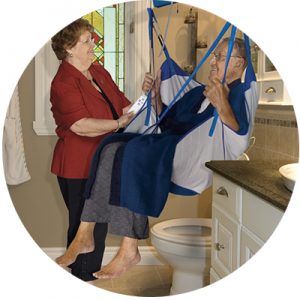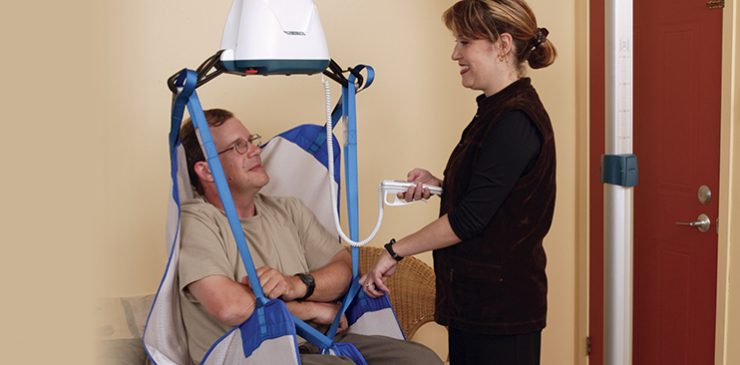“We would love to go for a walk together in the afternoons, maybe go to the park sometimes. But we don’t have the support we need for Kenny to be able to leave the house. He is basically housebound right now.”
Betty Leung is describing life since July 2019, when her husband Kenny acquired a spinal cord injury. After six months in rehabilitation, the Leungs arrived home to part-time care for Kenny, focusing mainly on a morning routine of getting out of bed, personal care, eating and spending a few hours in his wheelchair. By the time his Personal Support Worker and attending nurse leave—the nurse after two hours and the PSW after a few more—Kenny must be transferred back into bed for the rest of the day and night.
In rehab, Kenny had access to a ceiling lift for his transfer needs. At home, he has a hoyer lift. Because neither his PSW nor his nurse are permitted by their agencies to operate the lift on their own, and Betty is not able to safely manage it herself, Kenny can only be transferred during the morning hours when there are two people available. This places serious limitations on the Leungs’ life, as Kenny must be lifted back into bed midday until the following morning. For the rest of the day and throughout the nights, Betty does her best to cover all of Kenny’s needs. But it’s an exhausting cycle.
“I estimate that about 75% of Ontarians who need one do not have a lift and transfer device at home. This has a tremendous negative impact on their daily safety, level of care and quality of life. There is no acceptable or logical reason why these devices are not funded,” says John. “Government-funded mobility devices are a good start to help alleviate the financial burden imposed on families, but funding transfer devices as well would close the loop and provide the best and most safe solution, both clinically and financially, for families.”
– John Banfai, Project Manager, Lift & Elevating Devices
A ceiling lift would help to resolve this problem, as it makes it much easier for only one person—perhaps even just Betty—to transfer Kenny. But without access to funding, it’s not an option for the Leungs.
 “We were lucky to receive the Hoyer lift as a donation,” says Betty. “It’s an expensive device, and right now, it needs to be serviced. We’re not sure if we’re having a battery issue or it’s the machine itself. If the machine has reached the end of its life, we don’t know where we would find the funds to replace it. Honestly, we haven’t even thought that far ahead. We’re just getting by day to day right now.”
“We were lucky to receive the Hoyer lift as a donation,” says Betty. “It’s an expensive device, and right now, it needs to be serviced. We’re not sure if we’re having a battery issue or it’s the machine itself. If the machine has reached the end of its life, we don’t know where we would find the funds to replace it. Honestly, we haven’t even thought that far ahead. We’re just getting by day to day right now.”
John Banfai, Project Manager, Lift & Elevating Devices (Ontario) for Motion (formerly Motion Specialties), Canada’s leading mobility and home accessibility equipment provider, has met many people like the Leungs throughout his more than 15-year career at Motion. He is as disheartened as they are about the fact that Ontario’s Assistive Devices Program (ADP) does not provide funding for lift and transfer devices.
“Mobility devices and transfer devices are not exclusive of one another and should be viewed in the context of a complete package, thus funded as such,” says John. “Ontario health care institutions such as hospitals and long-term care facilities have long since identified the risks and financial impacts of injury to both client and caregiver associated with transferring to and from a mobility device. As a result of many studies and claim audits, the correlation between mobility devices and transfer equipment has been identified and are budgeted accordingly to outfit facilities with patient transfer devices (e.g. ceiling lifts, floor lifts).”
“Ontario is well behind other provinces,” continues John. “Our provincial government neither subsidizes temporary rental equipment when people are transitioning home from rehab nor the permanent home-based products they need to live full, productive and independent lives. We’re decades behind British Columbia, Alberta and Quebec, for example, which have household equipment like lifts in the same category as mobility devices like wheelchairs. In those provinces, people with SCI and other conditions receive the necessary funding.”
Without that funding, John knows of many families unable to afford any kind of lift and transfer device. The vast majority of Ontarians with SCI are being lifted and transferred by caregivers and family without any equipment at all, exposing themselves and their loved one to serious injury. For understandable safety reasons, PSWs and nurses are increasingly refusing to lift a client without a device. Even with a floor lift (commonly referred to as a Hoyer lift), their occupational health and safety training often requires two people to manage a transfer.
“I estimate that about 75% of Ontarians who need one do not have a lift and transfer device at home. This has a tremendous negative impact on their daily safety, level of care and quality of life. There is no acceptable or logical reason why these devices are not funded,” says John. “Government-funded mobility devices are a good start to help alleviate the financial burden imposed on families, but funding transfer devices as well would close the loop and provide the best and most safe solution, both clinically and financially, for families.”

SCIO Regional Services Coordinator Nouma Hammash is fully aware of how many clients are looking for donated equipment, given the absence of funding. Of course, demand exceeds supply. She notes that applying to charities for funding is a painful and time-consuming process with hit-and-miss results. It is not always clear why some clients receive funding while others do not.
“The challenge extends beyond acquiring a lift, which many families and individuals cannot afford,” says Nouma. “If a hoyer lift is acquired—by far the most common lift in use—most agencies insist that two people operate it. Generally, that means the PSW and a family member, which means that the family member cannot leave the house for work or to cover basic chores like groceries even while the PSW is present. And what if a person lives alone? They require two individuals, doubling the hours of care, while there is a shortage all round of attendants and PSWs. It’s a huge strain on resources.”
Nouma points out that the Centre for Independent Living (CILT) in Toronto provides safety training for attendants so that they can operate a hoyer lift on their own. Only four agencies have availed themselves of this service, and there is a long waitlist for CILT-trained attendants. This means that the vast majority of those living with an SCI continue to need two people for lift and transfer.
“Families are making up the difference for the shortage of PSWs and attendants,” says Nouma. “It places enormous stress on the whole family system and on intimate relationships, which only increases if someone gets hurt during a lift. Elderly spouses and those with other health issues should not be lifting. And those who live alone often have to patch together care options involving professionals, neighbours, friends, and family members who live at a distance.”
Before receiving his ceiling lift, which was donated by Muscular Dystrophy Canada, Lucien Timofte relied on such a patchwork system. Now 45 years old, Lucien has required caregiving since the age of 14. With a ceiling lift now operating in his bedroom and washroom, he can be transferred by one person (in theory—in practice, it doesn’t always work out that way). As Lucien is single, he often relies on church volunteers to help him when a PSW is not available. He has also experienced inconsistency in PSW training, being told at times that two PSWs are required to operate the ceiling lift.
“Ultimately, the agency empowers each PSW to accept or decline tasks or routines in regards to their clients,” says Lucien. “Some PSWs are not well trained on how to use lift and transfer devices and so, they cite safety reasons for not using them. Of course, quality training is required to operate equipment like this. I have found that some PSWs rely on family members to frequently show them how to use equipment and to operate it together. Well, I don’t have any family members to do that. So, with insufficient training, I don’t always know if I will get transferred out of bed.”
Living on a low income, Lucien struggles to pay the 25% of costs not covered by ADP when it comes to mobility devices. Without any government funding at all for lift and transfer equipment, he is concerned about people who cannot access donated equipment or funds—and knows he could be one of them at any time. In addition, with an educational background in accessibility and inclusive design, he is frustrated that products, services and regulations are not reliably designed and co-created with users from the disability community.
“Participatory design is essential,” he says. “People with disabilities need options and customization in every area affecting their lives, including the funding of assistive devices, their repairs, and connected services. Feelings of isolation, fear and powerlessness are pervasive in the disability community and have worsened even more during the pandemic. The pandemic has only magnified all the issues of accessibility that have not been properly addressed. The multiple issues around lift and transfer and around attendant care are part of that picture.”
Both Lucien and the Leungs are in the process of applying to the Direct Funding program, which supports self-managed attendant services in Ontario. They are hoping to fill in the gaps in their care, thus acquiring greater mobility and freedom. At the least, Betty is hoping she’ll be relieved of the approximate 18 hours a day that she is Kenny’s sole caregiver, allowing her to leave the house, get the sleep she needs, and take Kenny outdoors so they can both enjoy a better quality of life.
Whatever the outcome of their applications, however, the absence of funding for assistive devices remains a grave concern. “We need a solution to a massive underfunding issue in Ontario,” says John. “Our government has demonstrated that it knows the health and safety risks associated with lift and transfer but won’t fund the proper equipment. Why not?”






